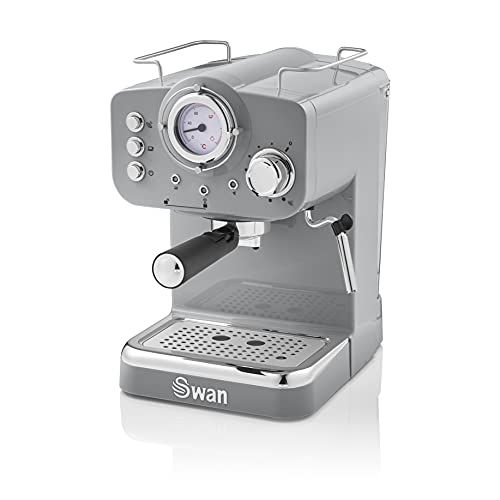How Does Machine Espresso Work?
Machine espresso uses precision pressure and mind-blowing filter technology to create the perfect cup of coffee. What exactly is it?
Espresso is produced by pushing hot water under pressure through finely-ground coffee. The process is similar to that of making drip coffee. However the pressure is the major difference.
The Group Head
The group head is the portafilter that you place in the espresso maker when making it. It is responsible for dispersing the water into the portafilter and controlling the pressure of the extraction. There are a variety of group heads, each with its own advantages and drawbacks. Some focus on temperature stability, whereas others on pre-infusion features, and others are designed to control the lever. Some have a combination, like the E61. This is a favorite among baristas due to the fact that it has multiple benefits in one package.
As you can see in the photo above, the group head has a number of notches. You can place your portafilter into these notches and twist the head to lock it. There is also a gasket made of rubber in the notches and helps to create the seal when you insert your portafilter into the machine. The notches allow for precise placement of the portafilter. This is crucial to ensure an even extraction.
The group head does not just allow the portafilter to be inserted easily however, it also keeps the same temperature. It does this by cycling hot water through the brew container and around the portafilter, ensuring that it's always at the correct temperature to extract. It is crucial to keep in mind that even a small deviation can make the difference between a decent and a great espresso.
The Pump

The motorized pumps used in espresso machines rotary provide nine atmospheric bars of pressure required for espresso extraction. This is different from manual piston machines that use a lever. The pressure builds up by removing tap water from a reservoir, and pumping it through a heat exchanger prior it is shot through the ground coffee in the group head.
Pumps are typically cheaper and last longer than piston-driven machines. However, both kinds of machines are susceptible to degrading because of excessive use and poor cleaning. Pumps are also more complicated mechanically, which can increase the cost of even simple models.
Some espresso machines make use of steam pressure instead of a pump for brewing espresso. cafe espresso machine can cause over-extraction because the boiler that produces steam also heats the water until it comes to a boil. Additionally the machines often have to restore their pressure between cups, which takes time and energy.
Many espresso machines make use of the rotary or vibration pump, which is a vibration model using a vibrating disc to generate the pressure, and an rotary model that pushes hot water through the grounds at high speed. Both machines can make excellent espresso, however rotary machines are more quiet, durable and less likely to break.
The Boiler
The boiler will heat the water to a temperature that is ideal for extraction. The steam that is produced will eventually reach the portafilter, which is a container for espresso grounds. The steam is then channeled into the cup. During this process the steam is able to create enough pressure to push the grounds of coffee through. This creates a crema on the top of the espresso. This is the hallmark of a good espresso.
There are three kinds of espresso machines, each with different types of pumps and the temperature of the brew. There are a variety of ways to control the brew and the size of the cup that can be produced by the machine.
The first espresso machines were steam-type. The earliest espresso machines were steam-type machines. The coffee tasted bitter and burnt. This is the reason why Milanese producers Luigi Bezzerra and Desiderio Pavoni invented the modern espresso machine.
The most popular espresso machine is a semiautomatic one with an electric pump. This is what people envision when they think of an espresso machine. Semi-automatic machines require you to grind and tamp the beans by yourself while the pump controls the water flow and pressure. This is a perfect combination of human control and mechanized consistency.
The Filter
Typically, espresso machines employ filters that separate the coffee grounds as they pass through the hot water. The filter is also a vital part of the temperature control system as it keeps the machine from overheating.
It also aids in flavor, as it allows for a more prolonged bloom phase. This helps the beans release their flavors and provides an opportunity for better extraction.
It is important to remember that even the most efficient filter can make a bad cup of coffee. The quality of the beans and the extraction process remain vital.
It's here that the magic takes place. This is the reason why espresso tastes so good. The grouphead (also called the brewhead) is where you place the portafilter, the device that you use to put the grounds of your coffee into while making espresso.
In a steam-driven espresso machine, hot water is heated in an airtight container to produce steam, which is then pushed through the grounds at high pressure. These kinds of machines are usually cheaper and easier to maintain than pumps-driven models. They are however limited in their ability for creating the ideal conditions for brewing, as they operate with 1-1.5 bar of pressure. The ideal shot requires 9-10 bars.
In recent times, espresso machines powered by a compressed air pump have become increasingly popular. They use an air compressor to push hot water into the grounds and are much more portable than electric steam-driven machines.
